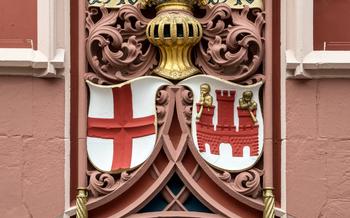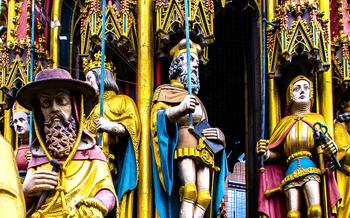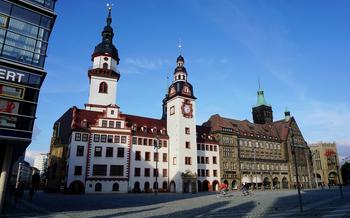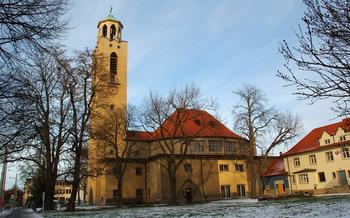
Maximilian's Fountain
- Maximilian's Fountain: A Monumental Masterpiece
- Unveiling the Fountain's History
- Artistic Symbolism and Meaning
- Exploring the Fountain's Design
- Admiring the Fountain's Architecture
- Experiencing the Fountain's Surroundings
- Maximilian's Fountain: A Symbol of Opulence
- Maximilian's Fountain: A Symbol of Regensburg's Cultural Significance
- Maximilian's Fountain in Literature and Art
- Myths and Legends Surrounding the Fountain
- Whispers of Enchantment and Mystery
- Restoring Maximilian's Fountain to Its Former Glory
- The Fountain's Impact on Tourism
- A Cultural Beacon Drawing International Visitors
- Visiting the Maximilian's Fountain
- Insider Tip: Capturing the Best Moments
Maximilian's Fountain: A Monumental Masterpiece
In the heart of Regensburg, Germany, stands a testament to the city's rich history and artistic legacy - Maximilian's Fountain. This awe-inspiring monument, situated near the Stadtpark, is not just an ordinary fountain but a masterpiece of Gothic and Renaissance art. Its historical significance and cultural importance make it a must-see attraction for any traveler visiting Regensburg.
The fountain's construction in the early 16th century marked a period of prosperity and affluence for the city. Wealthy merchant Hans Deggendorfer commissioned the fountain as a symbol of Regensburg's economic power and influence. The intricate sculptures and architectural details that adorn the fountain showcase the exceptional craftsmanship and artistry of the period.
Maximilian's Fountain stands as a symbol of Regensburg's pride and its status as a thriving trading hub. Its grandeur and opulence reflect the city's wealth and prosperity during the Middle Ages.
Unveiling the Fountain's History
The genesis of Maximilian's Fountain can be traced back to the vision of Hans Deggendorfer, a wealthy merchant and council member of Regensburg. In 1543, Deggendorfer commissioned the construction of the fountain as a testament to his devotion to his city and his gratitude for its prosperity.
The fountain's creation involved an assembly of skilled artisans and craftsmen, each contributing their expertise to the intricate design. The fountain's central figure, depicting Maximilian I, Holy Roman Emperor, was crafted by the sculptor Hans Vischer the Elder, renowned for his work on the tomb of Emperor Maximilian in Innsbruck.
Initially, the fountain was placed in the city's main square, known as the Haidplatz. However, as the city expanded and traffic increased, the fountain's relocation became necessary. In 1854, it found its permanent home in the Stadtpark, where it remains to this day, commanding attention amidst the serene surroundings of the park.
Over the centuries, the fountain has undergone several restoration efforts to preserve its grandeur and ensure its longevity. In the 19th century, extensive cleaning and repairs were carried out to address damage caused by time and weather. More recently, in the 20th century, a comprehensive restoration project was undertaken, meticulously restoring the fountain's sculptures and architectural elements to their original splendor.
Artistic Symbolism and Meaning
The Maximilian's Fountain is not only a stunning work of art but also a testament to Regensburg's rich cultural heritage and religious beliefs. Its intricate sculptures and allegorical figures carry deep symbolic meanings, adding depth and significance to the fountain's overall design.
The fountain prominently features four female figures representing the cardinal virtues: Justice, Fortitude, Temperance, and Prudence. These virtues were highly valued in medieval society and symbolized the moral principles that governed people's lives. Justice is depicted holding a sword and scales, representing fairness and impartiality. Fortitude, with her lion companion, symbolizes strength and courage. Temperance, holding a water jug, represents self-restraint and moderation. Prudence, with a mirror and a serpent, embodies wisdom and careful judgment.
The fountain also incorporates mythological figures with symbolic meanings. The central figure of Maximilian I, Holy Roman Emperor, represents power and authority. The winged griffins, with their fierce appearance, symbolize strength and vigilance. The mermaids, with their enchanting beauty, represent the allure and mystery of the water.
Christian iconography is also present in the fountain's design. The figure of the Virgin Mary with the infant Jesus adds a religious dimension to the fountain and reflects the deep faith of the people of Regensburg. The fountain's intricate details and ornamental elements further enhance its artistic symbolism, creating a visual feast that captivates the viewer's imagination.
Exploring the Fountain's Design
The centerpiece of Maximilian's Fountain is the commanding figure of Maximilian I, Holy Roman Emperor, astride a majestic horse. His regal presence exudes power and authority, symbolizing his reign over the vast empire. Surrounding him are four elegant female figures, personifying the cardinal virtues: Justice, Fortitude, Temperance, and Prudence.
Each virtue is meticulously depicted with distinct attributes. Justice holds a sword and scales, representing her impartial judgment. Fortitude is symbolized by a column, signifying strength and resilience. Temperance empties a pitcher of water into a wine goblet, illustrating the balance between extremes. Prudence gazes into a mirror, reflecting her careful consideration before acting.
The fountain's design is further enriched by symbolic animals, lending additional layers of meaning. A powerful lion represents strength and courage, while a wise-looking pelican symbolizes selflessness and devotion. These creatures serve as potent visual reminders of the virtues they embody.
Intricate details and ornamental elements adorn the fountain, showcasing the artistry and craftsmanship of its creators. The spires and pinnacles reach towards the sky, lending a sense of grandeur and elevating the fountain's presence. The intricate carvings and tracery add a touch of delicacy and refinement, creating a harmonious balance between strength and elegance.
Admiring the Fountain's Architecture
Architecturally, Maximilian's Fountain is a masterpiece that blends Gothic and Renaissance elements. Its central feature is a towering Gothic spire, reaching towards the sky and adorned with intricate tracery and delicate pinnacles. The fountain's base, crafted from limestone and bronze, showcases intricate carvings and ornamental details, reflecting the artistic influences of both periods. The fountain's spires, buttresses, and niches add to its grandeur, creating a harmonious fusion of architectural styles that captivates the eye.
Experiencing the Fountain's Surroundings
The Maximilian's Fountain is nestled within the Stadtpark, a tranquil urban oasis that offers a respite from the bustling city. The park is adorned with lush greenery, vibrant flowers, and towering trees, creating a serene ambiance that complements the fountain's grandeur. Visitors can stroll along the park's winding paths, enjoying the tranquil atmosphere and admiring the fountain from various angles.
Surrounded by historic landmarks, the fountain serves as a focal point within the Stadtpark. The Old Town, with its cobblestone streets and medieval architecture, is just a short walk away. Visitors can explore the city's rich history by visiting the nearby Cathedral of Regensburg, the Old Town Hall, and the Stone Bridge, all within easy reach of the fountain.
The Stadtpark also hosts various events and activities throughout the year, making it a vibrant gathering place for locals and tourists alike. From concerts and exhibitions to markets and festivals, the park comes alive with energy and excitement. During these events, the fountain becomes a central stage, adding to the festive atmosphere and providing a backdrop for performances and celebrations.
Maximilian's Fountain: A Symbol of Opulence
Commissioned by the wealthy merchant, Hans Deggendorfer, during Regensburg's prosperous period in the 16th century, Maximilian's Fountain stands as a testament to the city's economic power and influence. It is a grand display of opulence and extravagance, reflecting the city's status as a vital trading hub and one of the wealthiest cities in the Holy Roman Empire. The fountain's elaborate design, intricate sculptures, and imposing size convey a sense of civic pride and prosperity, showcasing Regensburg's position as a prominent center of commerce and culture. It serves as a reminder of the city's rich historical heritage and its enduring legacy as a significant player in the economic and cultural landscape of Europe.
Maximilian's Fountain: A Symbol of Regensburg's Cultural Significance
Maximilian's Fountain holds immense cultural significance, transcending its aesthetic beauty and historical importance. Recognized as a masterpiece of Gothic and Renaissance art, the fountain has earned a place among Germany's most notable artistic creations. Its intricate carvings, allegorical representations, and fusion of architectural styles have made it a source of inspiration for generations of artists, writers, and musicians.
The fountain's cultural impact extends beyond its physical presence in Regensburg. It has been featured in numerous works of literature, including poems, novels, and short stories, where it serves as a backdrop for tales of love, intrigue, and historical events. Its unique blend of Gothic and Renaissance elements has also captured the attention of filmmakers and television producers, who have used the fountain as a setting for historical dramas and fantasy productions.
Maximilian's Fountain in Literature and Art
Maximilian's Fountain has captured the imagination of artists, writers, and musicians throughout history. Its unique blend of Gothic and Renaissance styles, intricate sculptures, and symbolic representations have inspired numerous works of art and literature.
Paintings, drawings, and engravings depict the fountain from various angles and perspectives, capturing its grandeur and intricate details. Poets and writers have used the fountain as a muse, weaving tales of love, loss, and historical events that unfold in its shadow.
The fountain's presence in novels and short stories adds depth and authenticity to the narratives, immersing readers in the rich cultural tapestry of Regensburg. Filmmakers and television producers have also been drawn to the fountain's visual appeal, using it as a backdrop for historical dramas, romantic comedies, and fantasy films.
Beyond Regensburg, the fountain's fame has spread, inspiring artists and writers from around the world. Its cultural significance extends far beyond the city limits, solidifying its place as a symbol of German artistic heritage.
Myths and Legends Surrounding the Fountain
Whispers of Enchantment and Mystery
Maximilian's Fountain is not just a magnificent work of art; it is also a source of local lore and legends, adding to its mystique and allure. Over the centuries, the fountain has been entwined with tales of magic, hidden treasures, and secret passages.
One captivating legend speaks of the fountain's magical powers. It is said that if a pure-hearted person makes a wish while touching the fountain's water, their wish will be granted. The fountain is believed to possess healing properties as well. According to local folklore, drinking from the fountain's water can cure ailments and bring good health.
Another intriguing tale revolves around hidden treasures buried beneath the fountain. It is rumored that a wealthy merchant, who commissioned the fountain's construction, hid a fortune in gold and jewels within its foundation. Treasure hunters have searched for centuries, but no one has ever found the hidden riches.
Legends also whisper of secret passages leading from the fountain to various parts of the city. These hidden tunnels are said to have been used by merchants to transport goods and escape during times of danger. While no physical evidence of these passages has been found, their existence remains a captivating part of the fountain's lore.
These myths and legends have been passed down from generation to generation, adding to the fountain's charm and mystique. They enhance the visitor's experience, creating a sense of wonder and enchantment that lingers long after they leave Regensburg.
Restoring Maximilian's Fountain to Its Former Glory
In the 20th century, Maximilian's Fountain underwent extensive restoration efforts to preserve its grandeur and historical significance. Recognizing the fountain's immense cultural value, experts embarked on a meticulous process of cleaning, repairing, and restoring its intricate sculptures and architectural elements.
Time, weather, and pollution had taken their toll on the fountain's delicate limestone and bronze surfaces. Skilled artisans worked tirelessly to address the damage, carefully cleaning each sculpture and repairing any cracks or missing parts. The fountain's intricate tracery and carvings were meticulously restored, bringing back the intricate details that had been obscured by the passage of time.
The restoration project also involved addressing structural issues to ensure the fountain's stability and longevity. Engineers and architects collaborated to reinforce the fountain's base and foundation, ensuring that it could withstand the test of time and continue to grace the city of Regensburg for generations to come.
Through the dedication and expertise of the restoration team, Maximilian's Fountain was brought back to its former glory. Today, it stands as a testament to the city's rich history and artistic heritage, continuing to captivate visitors with its intricate beauty and symbolic significance.
The Fountain's Impact on Tourism
A Cultural Beacon Drawing International Visitors
Maximilian's Fountain has emerged as a prominent tourist attraction in Regensburg, captivating visitors from across the globe. Its historical significance, artistic grandeur, and unique charm have made it a must-see destination for those exploring the city's rich cultural heritage. The fountain's inclusion in guided city tours and walking itineraries ensures that visitors have ample opportunities to admire its beauty and learn about its fascinating history. Whether you're an art enthusiast, a history buff, or simply someone who appreciates architectural marvels, Maximilian's Fountain promises an unforgettable experience. Capture the moment with your camera and share your Instagram-worthy shots with the world, showcasing the splendor of this iconic landmark. As you stand before this masterpiece, you become part of a global community of travelers who have been captivated by its timeless allure.
Visiting the Maximilian's Fountain
Maximilian's Fountain can be visited and admired year-round during daylight hours. It is a free and publicly accessible attraction, requiring no reservations or tickets. Simply stroll to the fountain's location within the Stadtpark and take in its splendor. As a must-see attraction in Regensburg, the fountain offers ample opportunities for exploration, contemplation, and capturing memorable photographs. Whether you're a history buff, an art enthusiast, or simply someone who appreciates exquisite craftsmanship, Maximilian's Fountain is a captivating sight that will leave a lasting impression.
Insider Tip: Capturing the Best Moments
To truly appreciate the splendor of Maximilian's Fountain, consider visiting during the early hours of the morning or as the sun begins to set. At these times, the crowds are typically smaller, allowing you to soak in the fountain's grandeur without distractions. Moreover, the soft, golden light of dawn or dusk casts a magical glow on the fountain, creating a picturesque scene that's perfect for capturing stunning photographs. Whether you're an amateur photographer or simply seeking a serene moment of contemplation, an early morning or evening visit to Maximilian's Fountain is highly recommended.




